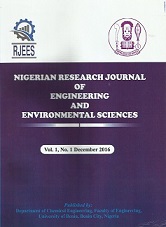Tripping Zone Accuracy of Distance Relay Protection for a 33 kV Distribution System with Varying Fault Type and Impedance
Authors: *Oputa, O., Ogbuka, C.U., Diyoke, G.C., Onwuka, I.K. And Madueme, T.C.
DOI Info: http://doi.org/10.5281/zenodo.10442845
ABSTRACT
The zone at which a Distance protection scheme (DPS) trips when a fault occurs on a line the DPS is protecting is ideally thought to be just dependent on the location at which the fault occurred. However, it has been shown in this paper through simulations in PSCAD that the trip location depends on not only the fault location but also depend on the fault impedance, type of fault and the phase(s) involve in the fault. The PSCAD simulation of an impedance fault of 0.1 Ω occurring at 50 km (Zone 1) on Line 1 for a line ‘A’ to ground fault (AG) trips inaccurately at Zone 2 while for a BG fault, it trips accurately at Zone 1. Also, line ‘A’ to line ‘C’ fault at the same location trips at Zone 1 for fault impedances of 0.1 Ω and 1 Ω. The same fault at the same location across the same line trips in Zone 2 and Zone 3 for fault impedance of 5 Ω and 10 Ω respectively. This buttress the fact about the trip zone stated above. Also, test carried out shows an average tripping zone accuracy of the distance relay of 62.5%.
Affiliations: Department of Electrical/Electronic Engineering, Michael Okpara University of Agriculture, Umudike, Nigeria.
Keywords: Trip Zone Accuracy, Distance Relay, Varying Fault Type, Varying Fault Impedance, Distance Protection
Published date: 2023/12/30









